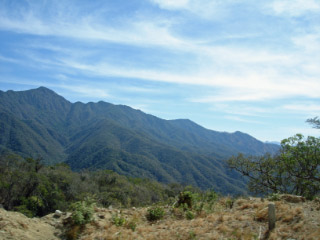
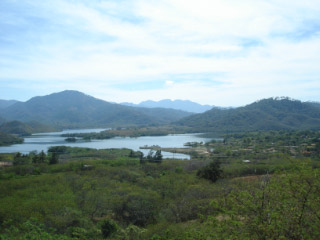

Chapter 7. Central Chiapas



(Bert) From our campground not far from the Pacific coast we head inland on the Isthmus of Tehuantepec until the coastal plain nears the uprising mountains. We see the first of hundreds of windmills, giant three-armed soldiers regimented in long rows and columns reminiscent of scenes from Star Wars. Today, some are idle, many turn slowly in the relatively calm wind, yet this area can experience fierce winds. I wonder how much electricity they generate and how wide a population area they service.
We travel on the border of the coastal plain, an arid brush land paralleling the mountain range out of the State of Oaxaca and into the State of Chiapas. The roadsides hear are unusually free of liter and an oft-posted sign suggests why. Literally translated, the sign states “Penalty for throwing trash – 90 salaries minimum”. Through a partially wooded area, Shari and I see a gorgeous large yellow and green bird fly across the road and non-birder Shari recognizes it as a trogon. By range maps and habitat, it must be a Citreoline Trogon. After paying entrance to the toll road at KM marker 1, we begin a serious uphill climb. Designed so that the highway goes steadily upward at about 5-7º, and not once descending, I move at 40 mph until KM marker 42. We’ve climbed over 7000 ft. without a break. I’m impressed with how well the Chevy engine in R-Pup-Tent performs. I doubt the Caterpillar diesel engine in our much larger R-Tent-III could have climbed steadily that long without slowing, as it always does when we grind through the mountains above Denver.
We have been concerned about the road logs, as this route has not been run in this direction and we had to interpret them in reverse. We actually have been using two logs and together with our updates they have been manageable, including the route through and around the congested city of Tuxtla Gutierrez. The last leg has been the cuota road which dumps us right into San Cristóbal at a corner with Pemex 8395. Trouble is there is no way to orientate ourselves so as to make sense of the last two instructions. We and the three rigs behind us pull off to the side of the boulevard. The others stay parked at the Pemex intersection. I unhook the tow car and while I stay with the caravan, Shari takes the GPS and FRS radio and drives the car into the city to find the hotel and adjoining RV park.
(Shari) “Necesito usted ir a con me in mi carro y guia me aqui” I tell the Spanish speaking lad at the desk. He looks at me strangely, probably wondering why I need a guide when I am already here. I wish I knew the word “lost” in Spanish. You see the caravan is about two miles away on a road and I do not know how to get them to the hotel. I had intended to write about the pretty drive through the mountains and negotiating the large city of Tuxtla Gutierrez, but then we got lost. We were going along just fine, following the road log and the GPS tracks, when all of a sudden the tracks stop and the road log makes no sense. Bert and I have some words on what to do next. Men never want to stop for directions.
We pull the caravan to the side of the road where they can safely wait while we unhook the car and I try to find the hotel. I realize the tracks are wrong and I call on the FRS radio for someone to read me the coordinates listed in the book. Janice hears me and her voice comes through with lots of static but I get the gist of what she says. I wiggle my way through the streets trying to get closer to the dot that marks the hotel on my GPS. I make a returno, a right turn, another right turn, another returno and then with much relief, I see the hotel on my left.
By now I realize the big rigs will never make all those U-turns. I tell the desk clerk that I need his help. He misunderstands and directs me to parking in back of the hotel. I try again telling him I have 12 rigs stranded. I do not know the word for stranded so I wave my arms frantically a lot pointing in the direction the caravan is parked. He must realize I am distressed since he finally gets in the car with me. I retrace my steps and we see the caravan. He shows me the way but does not realize I want the caravan to follow. So I have to go back again. I make another returno and come up on the caravan from behind telling them to follow me. We have to make a U-turn on a busy intersection and I almost get hit by traffic. Everyone has to stay in the right lane, swing wide left and make the U-turn. I ask Larry and Marlene to block the left lane with their motor home. We only can do this on green lights and we are making lots of Mexican drivers anxious as they honk their horns at us. Slowly we inch up the road as one by one Pods 2 and 3 make the turn until I hear the word “jackknife”. Apparently Bob and Heather could not make the turn and did indeed jackknife. I hear the stress in their voices as they try to get themselves out of their predicament. All of a sudden Marlene is saying they have all made the turn.
Off we go with eight rigs, the other four (Pod 1) who did not get the word in time to stop and pull over have to wait until these eight are in. They will have to go another way. In city traffic we go down the road, right turn, another right turn and then a right into the hotel. Only four more to go! I tell the lad I still need him to guide me and we go out to retrieve the last four. Bert’s FRS radio looses battery about now and he doesn’t hear that our guide changed his mind about a U-turn and Bert makes the wrong turn. I calmly tell Jim to communicate with him on the CB. Pod 1 turns left at a busy intersection and then another left and then straight into the hotel.
Margaritas are late but very welcome. Everybody toasts my abilities to go off on my own, find the hotel from a GPS coordinate, and bring help. I just think, there was nothing else to do. The group starts to say hilarious things; I wish I could remember what they all are. I guess I have had a little too many margaritas too.
 (Bert) Our birding guide does not show up at the designated 6:15 departure
time. I started arrangements over three months ago, with huge delays in getting
a response from Mexico. My last correspondence was a week ago, to which I did
not get an answer. On our itinerary, San Cristóbal is the one place I have not
birded before, so the main reason I need a guide is to learn how to get out of
the city to the preserve at Cerro Huitepec. Shari and I spent 45 min. last night
asking for directions and trying to get a local map. I have a vague idea of how
to get there and plan on hiring a taxi to lead us if I get lost. As it turns out
I don’t make a wrong turn and the total drive is only 3.4 mi.
(Bert) Our birding guide does not show up at the designated 6:15 departure
time. I started arrangements over three months ago, with huge delays in getting
a response from Mexico. My last correspondence was a week ago, to which I did
not get an answer. On our itinerary, San Cristóbal is the one place I have not
birded before, so the main reason I need a guide is to learn how to get out of
the city to the preserve at Cerro Huitepec. Shari and I spent 45 min. last night
asking for directions and trying to get a local map. I have a vague idea of how
to get there and plan on hiring a taxi to lead us if I get lost. As it turns out
I don’t make a wrong turn and the total drive is only 3.4 mi.
We arrive before the gates to the high wire mesh fence are open and while
waiting we see our first Rufous-collared Robin and then a Blue-and-white
Mockingbird, life birds for most if not all of those birding this morning,
except me. The gates soon open and we hike up into the dense forest which
overlooks the city, a tiny remnant of what must once have covered the whole
area. Old trees are contorted in grotesque shapes, a result of many years of
trimming branches for firewood and a practice now stopped by the 8 ft. fence
surrounding the preserve managed by Pronatura Chiapas. The forest, elevation
2330 m., is still dark and quiet, except for several calling Mountain Trogons.
As the air warms we hear the chips and chirps of warblers high in the canopy,
the enchanting chorus of Singing Quail and the melodic song of a Gray-breasted
Wood-Wren. We see none until we come to a steep clearing covered with tall
grasses and flowers. Across the western edge, the rising sun illuminates the
tall deciduous trees and a parade of warblers passes through, feeding in the
canopy. It’s a slow parade with lots of characters: 15 warbler species, 5
hummingbird species, a few flycatchers and a Hairy Woodpecker. Tom announces a
Pink-headed Warbler, a principal target for today, and we quickly ask for
directions. It disappears and then I relocate it in another darkly shaded tree,
but it too disappears. Tom and I are the only ones to see it, and our look is
BVD: better view desired. Mike photographs an Amethyst-throated Hummingbird and
while we are trying to find where he is looking, we see another large
hummingbird conveniently perched atop a bare branch on the foreshortened
horizon, a Garnet-throated Hummingbird, a life bird for me.
(Shari) After margaritas last night, Bert and I walked across the street to the shopping mall and at McDonald’s we ate Big Macs and fries, something we only do every few years. It did not sit well with me and I slept fitfully so I get up soon after Bert has left at 6:15. I spend the morning doing chores, bagging laundry to take to the lavanderia, defrosting the frig, taking a shower, washing last night’s margarita dishes, etc. and at 11, Larry, Marlene and I retrace out steps from yesterday and write a decent road log on how to get into the park from the toll road. We then scout out our exit to Palenque for tomorrow. Happy Hour starts early and I join a group at 4:30. Janice has a silver looking tea pot and offers me a cup. It tastes wonderful and hits the spot as the temperature is getting chilly. We toast and sing Happy Birthday to John. In about an hour, it gets too cool to sit outside and many go to the restaurant for a beer before our scheduled 6:30 LEO (Let’s Eat Out).
(Bert) Coincidentally, I met Javier yesterday noon at Cerro Huitepec and made arrangements for him to meet us at 6 AM this morning. He was to be our guide yesterday, but the message was not relayed to him. Oh, well, now we have him today instead. When we arrive at KM 2 on the Ocosingo Road, the temperature is only 34º, so I put on another coat over my clothes. Walking through the tall pine forest is not uncomfortable though, as we hike uphill and listen to the sounds of dawn. Mountain Trogons are again the most conspicuous call, as well as Brown-backed Solitaire and the usual proliferation of unseen warblers and hummingbirds. I also hear an oriole and from our checklist possibilities I suspect it is Yellow-backed, which Javier confirms. Javier also identifies the calls of Hutton’s Vireos, which seem to be numerous in these high altitude forests. Our targets are Pink-headed Warbler and Unicolored Jay. Maxine gets a brief glimpse of the warbler, but none of us can relocate the bird. The leafy understory and the very tall canopy make repeat sightings of a momentary flash of wings almost impossible, especially in the dim light preceding sunrise. We continue walking, hoping to chance upon a mixed flock.
Our first good find is one, then two, then three Spot-crowned Woodcreepers together surveying pine trunks. Javier recognizes the calls of Unicolored Jays and as we walk in their direction, they choose another and the call recedes to another part of the forest. Direct sunlight is beginning to highlight the pine crowns and we can identify a few warblers.
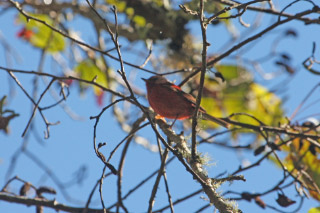 Javier, who birds without binoculars or scope, finds a Pink-headed Warbler
and we rush to his side. This time the Pink-headed resumes its feeding frenzy
and we follow it from one flowering shrub to another, not much above eye level.
With a bright red body and a Mary Kay pink head, it stands out even among the
bright flowers and radiant sun spots on clustered leaves. After everyone has
gotten a good look, out come Bob’s and my 400 mm cameras and Paul brings in his
600 mm, which he routinely has equipped with an expander bringing his
magnification almost to 1000 mm. We are so close to the warbler and the bird is
so enmeshed in foliage, focusing on the bird is almost impossible and I collect
75 out-of-focus images. No matter, we have our fill of watching this precious
bird, one whose range is restricted to the mountain tops of southern Chiapas and
northern Guatemala. For me especially, the sighting is rewarding because we
tried hard to find Pink-headed last March at the best location in Guatemala and
did not.
Javier, who birds without binoculars or scope, finds a Pink-headed Warbler
and we rush to his side. This time the Pink-headed resumes its feeding frenzy
and we follow it from one flowering shrub to another, not much above eye level.
With a bright red body and a Mary Kay pink head, it stands out even among the
bright flowers and radiant sun spots on clustered leaves. After everyone has
gotten a good look, out come Bob’s and my 400 mm cameras and Paul brings in his
600 mm, which he routinely has equipped with an expander bringing his
magnification almost to 1000 mm. We are so close to the warbler and the bird is
so enmeshed in foliage, focusing on the bird is almost impossible and I collect
75 out-of-focus images. No matter, we have our fill of watching this precious
bird, one whose range is restricted to the mountain tops of southern Chiapas and
northern Guatemala. For me especially, the sighting is rewarding because we
tried hard to find Pink-headed last March at the best location in Guatemala and
did not.
On an emotional high, we lightly walk back to the parked cars. While we are
waiting for Jim and Betty to catch up with us – they birded in a different
direction and saw a Garnet-throated Hummingbird – I spot a robin which I first
think is a Clay-colored and then see its two-tone coloring and bright yellow
legs and bill. It puzzles us for a while and Paul and I start photographing it
while the others identify it as a female Rufous-collared Robin. Above us in the
same area, Javier hears a Unicolored Jay and this time it stays. Feeding above
the pine canopy, we get frequent looks at jay pieces through pine needles,
always the same dark blue color.
Already a successful morning, we drive to Chanal and bird along the mountain road. Truck traffic is heavy, a succession of log laden trucks carrying pine trunks downhill. One spot near us has been clear cut and neatly piled mounds built of vertically aligned sticks and board tops are scattered in the clearing. Javier tells us the locals are making charcoal. An aged man shuffles behind a donkey overladen with bags of charcoal, the pack animal knowing the way without guidance. We search diligently for Black-throated Jay in the still-standing pines, but find none. Of the places we visit today, Javier says this is the only one where we have a chance for the jay. Seeing the pines disappear is sad, as this not a managed tree farm, but a remnant of naturally growing forest. Warblers abound, though, and several in our group get their first sustained looks at Olive Warbler and Crescent-chested Warbler, and we see another Pink-headed Warbler. A lifer for most, I point out Common Bush-Tanager and we see many in the next hour.
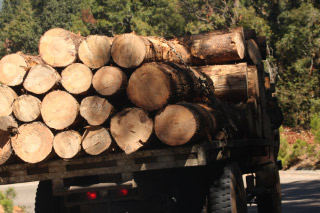
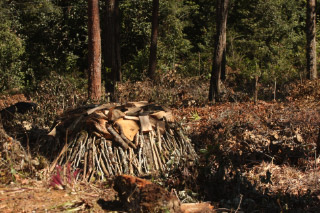
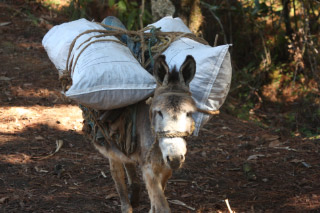
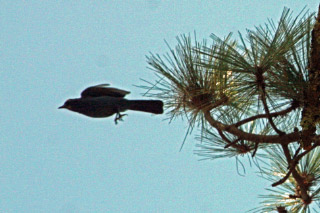 We have one more birding stop, Grutas de Rancho Nuevo, a large park
surrounding a vast cave system. It is noon now and birding is slow, yet the walk
on the cleared understory beneath the white pines is pleasant. We find just
enough birds to keep us interested, getting Yellow-eyed Juncos
We have one more birding stop, Grutas de Rancho Nuevo, a large park
surrounding a vast cave system. It is noon now and birding is slow, yet the walk
on the cleared understory beneath the white pines is pleasant. We find just
enough birds to keep us interested, getting Yellow-eyed Juncos
and more views of Unicolored Jays mixed
with Steller’s Jays. At first we think we can simply separate them by presence
or absence of raised crowns and then I notice some of the Steller’s are the
coronata subspecies whose raised crown is almost unnoticeable. We also get a
good look at a pair of Red-shafted Flickers. We quit birding in early afternoon,
a very successful day especially when I can count two life birds in the tally.